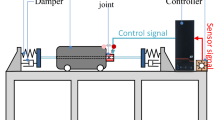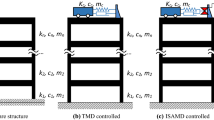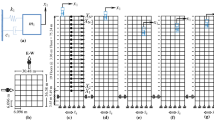Abstract
A new semi-active mass damper, included active joint to control Lock/Unlock between the mass of damper and structure, is proposed to avoid “de-tuning effect” in this study. A ten-floor shear building with Tuned Mass Damper (TMD) and Semi-Active Mass Damper (SAMD) under excitation of 26 earthquake records is simulated by numerical analysis to compare the shock absorption effects. Analysis results show that: (1) Shock absorption of roof displacement and root mean square (RMS) roof displacement is 9.9%, 15.8% and 67.9%, 70.9% for structure with TMD and SAMD under excitation of Kobe 1995 earthquake respectively. Shock absorption of roof displacement and RMS roof displacement 52.7%, 62.1% and 55.7%, 66.3% for structure with TMD and SAMD under excitation of Sumatra 2007 earthquake respectively. (2) Structural response of building with SAMD controlled is very low sensitivity to frequency ratio. SAMD control effect is better than that of TMD on near fault earthquakes and suitable for far-field earthquakes. Otherwise, SAMD is almost without “de-tuning effect”. (3) Shock absorption ratio of the roof displacement responses and RMS displacement responses for structure with SAMD under excitation of far-field earthquake is above 38% and 62%, respectively. The frequency ratio of SAMD controlled should be limited to less than 4.0 to avoid enlarging the maximum acceleration responses. The practicability of this proposed SAMD has been verified by numerical analysis.








Similar content being viewed by others
References
Soto M G and Adeli H 2013 Tuned Mass Damper, Archives of Computational Methods in Engineering 20(4): 419–431
Xiang P and Nishitani A 2014 Seismic vibration control of building structures with multiple tuned mass damper floors integrated, Earthquake Engineering and Structural Dynamics 43(6): 909–925
http://bsbgltd.com/blog/the-mechanism-and-applications-of-tuned-mass-damper-tmd/
Webster A C and Vaicaitis R 2003 Application of Tuned Mass Dampers To Control Vibrations of Composite Floor Systems, Engineering Journal 7(1): 116–124
Farghaly A A and Ahmed M S 2012, Optimum Design of TMD System for Tall Buildings, ISRN Civil Engineering, 2012, Article ID 716469, 13 pages, http://dx.doi.org/10.5402/2012/716469
Gattulli V, Di Fabio F and Luongo A 2003 One to one resonant double Hopf bifurcation in aeroelastic oscillators with tuned mass dampers, Journal of Sound and Vibration 262(2): 201–217
Hazra B, Sadhu A, Lourenco R and Narasimhan S 2010 Re-tuning tuned mass dampers using ambient vibration measurements, Smart Materials and Structures 19(11): https://doi.org/10.1088/0964-1726/19/11/115002.
Karimi M 2016 A review of the using Tuned mass dampers in the high-rise buildings, International Journal of Scientific and Engineering Research 7(6): 962–966
Shih M H, Sung W P and Go C G 2002 Development of Accumulated Semi-Active Hydraulic Damper, Experimental Techniques 26(5): 29–32
Fisco N R and Adeli H 2011 Smart structures: Part I - Active and semi-active control, Scientia Iranica 18(3A): 275–284
Palacios-Quiñonero F, Rubió-Massegú J, Rossell J M and Karimi H R 2012 Semi-active-passive structural vibration control strategy for adjacent structures under seismic excitation, Journal of the Franklin Institute 349(10): 3003–3026
Shih M H and Sung W P 2014 Development of Semi-Active Hydraulic Damper as Active Interaction Control Device to Withstand External Excitation, Sadhana - Academy Proceedings in Engineering Science 39(1): 123–128
Hiramoto K, Matsuoka T and Sunakoda K 2014 Simultaneous optimal design of the structural model for the semi-active control design and the model-based semi-active control, Structural Control and Health Monitoring 21(4): 522–541
Liu K, Chen L X and Cai G P 2011 Active control of a nonlinear and hysteretic building structure with time delay, Structural Engineering and Mechanics 40(3): 431–451
Zeng X, Peng Z, Mo L, Su G Y 2014 Active Control Based on Prediction of Structural Vibration Feedback, In: 2014 Fifth International Conference on Intelligent Systems Design and Engineering Applications, https://doi.org/10.1109/isdea.2014.35
Shih M H and Sung W P 2020 Structural Control Effect and Performance of Structure Under Control of Impulse Semi-active Mass Control Mechanism, Iran J. Sci. Technol. Trans. Civil Eng. https://doi.org/10.1007/s40996-020-00387-9
Acknowledgements
The authors would like to thank the Taiwan Ministry of Science and Technology for the support through Grant Nos. MOST-105-2221-E-260-003 and MOST-105-2221-M-167-001.
Author information
Authors and Affiliations
Corresponding author
Rights and permissions
About this article
Cite this article
Shih, MH., Sung, WP. Development of semi-active mass damper with impulsive reaction. Sādhanā 45, 150 (2020). https://doi.org/10.1007/s12046-020-01395-1
Received:
Revised:
Accepted:
Published:
DOI: https://doi.org/10.1007/s12046-020-01395-1




